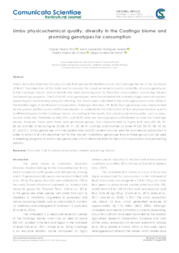Umbu physicochemical quality, diversity in the Caatinga biome and promising genotypes for consumption.
Umbu physicochemical quality, diversity in the Caatinga biome and promising genotypes for consumption.
Author(s): SILVA, V. P.; FERREIRA, M. A. R.; OLIVEIRA, V. R. de; FREITAS, S. T. de
Summary: Umbu (Spondias tuberosa Arruda) is a wild fruit species distributed all over the Caatinga biome in the Northeast of Brazil. The objective of this study was to analyze the physicochemical quality variability of umbu genotypes in the Caatinga biome, and to identify the most promising ones for fresh fruit consumption, processing industry and breeding programs. The fruit of 69 umbu genotypes were harvested at the maturity stage known as swollen, presenting full size and beginning of softening. The plants were cultivated in the umbu germplasm bank (UGB) at the Brazilian Agricultural Research Corporation, Embrapa, Petrolina, PE, Brazil. Each genotype was characterized by the global position system (GPS) coordinates to understand the distribution of fruit physicochemical quality in different regions in the Caatinga biome. According to the results, fruit physicochemical quality, such as mass, soluble solids (SS), titratable acidity (TA), and SS/TA ratio are homogeneously distributed all over the Caatinga biome. However, there were three main genotype groups, one characterized by higher fruit mass (52, 55, 57, 60, 65, and 68), other by higher SS (08, 09, 11, 20, 38, 41, and 62), and another by lower AT (02, 03, 07, 08, 16, 24, 27, and 51). Umbu genotypes with the highest mass and SS content can be used for commercial production in order to obtain fruit with desirable trait for the market. In addition, genotypes from all three groups can be used in breeding programs to obtain new genotypes with all desirable traits for fresh fruit consumption and processing industry.
Publication year: 2024
Types of publication: Journal article
Unit: Embrapa Semi-arid Region
Observation
Some of Embrapa's publications are published as ePub files. To read them, use or download one of the following free software options to your computer or mobile device. Android: Google Play Books; IOS: iBooks; Windows and Linux: Calibre.
Access other publications
Access the Agricultural Research Database (BDPA) to consult Embrapa's full library collection and records.
Visit Embrapa Bookstore to purchase books and other publications sold by Embrapa.

